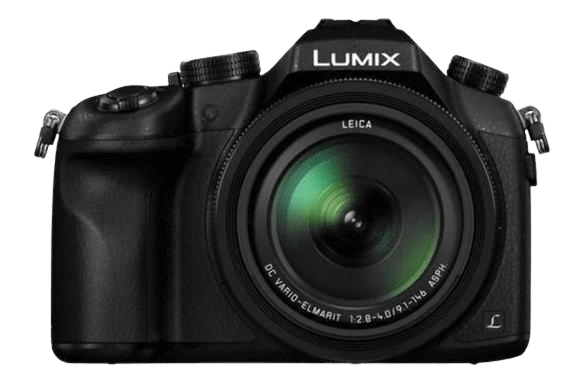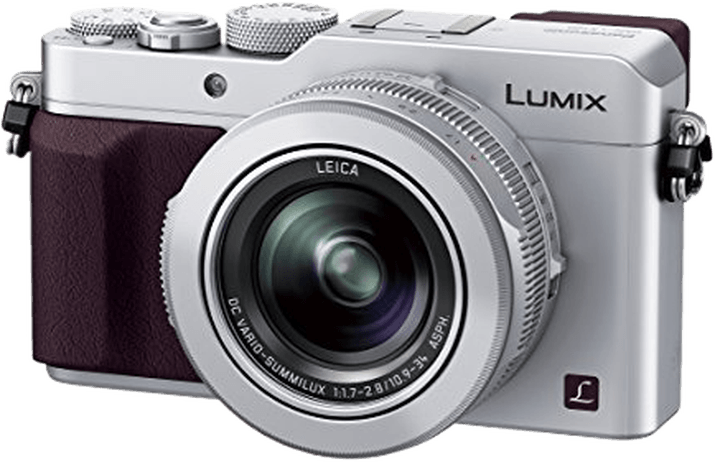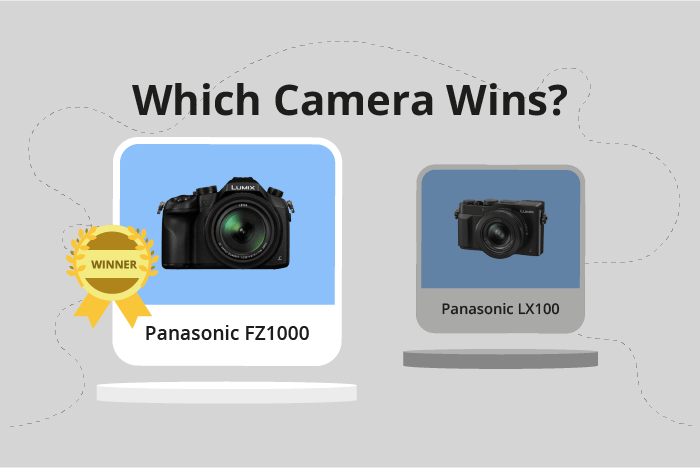Panasonic Lumix DMC-FZ1000 vs Lumix DMC-LX100 Comparison
Panasonic Lumix DMC-FZ1000

Panasonic Lumix DMC-LX100

The Panasonic Lumix DMC-FZ1000 triumphs over the Panasonic Lumix DMC-LX100 with a score of 57/100 compared to 49/100. Both cameras share the same announcement year (2014) and launch price ($899). The FZ1000, a bridge camera, outshines the LX100 compact camera with its larger size (137 x 99 x 131mm) and heavier weight (831g). This contributes to better handling and stability during shooting.
However, the LX100 has its advantages, including its smaller size (115 x 66 x 55mm) and lighter weight (393g), making it more portable and convenient for travel. Ultimately, the FZ1000’s superior performance earns it a higher score, while the LX100 offers a more compact option for those prioritizing portability.
Panasonic Lumix DMC-FZ1000 vs Lumix DMC-LX100 Overview and Optics
The Panasonic Lumix DMC-FZ1000 wins in optics with a score of 61/100, while the Panasonic Lumix DMC-LX100 scores 56/100. Both cameras share several specifications, such as having a CMOS sensor type, the Venus Engine processor, a fixed lens mount, image stabilization, and the inability to change the lens.
The FZ1000 proves to be better in several aspects. It boasts a higher megapixel count at 20, compared to the LX100’s 12.8 megapixels. This allows for more detailed and higher resolution images. Furthermore, the FZ1000 has a faster shooting speed of 12 frames per second, while the LX100 captures at 11 frames per second. This makes the FZ1000 more suitable for capturing fast-moving subjects or action shots. Additionally, the FZ1000 has a larger sensor size of 1″, which contributes to better image quality, especially in low-light conditions.
On the other hand, the LX100 has some advantages over the FZ1000. It has a higher DXOMARK score for the sensor at 67, compared to the FZ1000’s 64. This indicates that the LX100’s sensor performs better in terms of color depth, dynamic range, and low-light performance. Moreover, the LX100 has a 4:3 aspect ratio, which is more versatile for various photography styles and printing formats, compared to the FZ1000’s 3:2 aspect ratio.
In comparing the optics of these two cameras, the Panasonic Lumix DMC-FZ1000 comes out on top due to its higher megapixel count, faster shooting speed, and larger sensor size. However, the Panasonic Lumix DMC-LX100 remains a strong contender with its better sensor performance and versatile aspect ratio.
Panasonic Lumix DMC-FZ1000 vs Lumix DMC-LX100 Video Performance
The Panasonic Lumix DMC-FZ1000 emerges as the winner in video capabilities, scoring 83 out of 100, while the Panasonic Lumix DMC-LX100 scores 70. Both cameras share some common specifications, such as 4K maximum video resolution and 3840 x 2160 maximum video dimensions. They also both have built-in time-lapse functionality.
The FZ1000 outperforms the LX100 in terms of video frame rate, offering 60fps compared to the LX100’s 30fps. This higher frame rate allows for smoother and more detailed videos, particularly when capturing fast-moving subjects or scenes. This advantage makes the FZ1000 a better choice for videographers who prioritize the highest possible video quality and smoothness.
While the LX100 may have a lower video score and frame rate, it still offers impressive video capabilities. Its 4K video resolution and built-in time-lapse functionality make it a capable camera for capturing high-quality videos. The LX100 may be suitable for those who do not require the highest possible frame rate but still want to capture stunning videos.
In comparing the Panasonic Lumix DMC-FZ1000 and the Panasonic Lumix DMC-LX100, the FZ1000 is the superior choice for video capabilities due to its higher frame rate. However, the LX100 remains a strong contender with its 4K video resolution and time-lapse functionality. Users should consider their specific video needs and preferences when choosing between these two cameras.
Panasonic Lumix DMC-FZ1000 vs Lumix DMC-LX100 Features and Benefits
The Panasonic Lumix DMC-FZ1000 wins the comparison with a feature score of 58/100, while the Panasonic Lumix DMC-LX100 scores 41/100. Both cameras share several features, including a 3-inch screen size, flip screen, lack of GPS, and WIFI connectivity. However, the Lumix DMC-FZ1000 surpasses the Lumix DMC-LX100 in specific areas, making it the superior choice.
The Lumix DMC-FZ1000 has a higher screen resolution of 2,359,000 dots, compared to the Lumix DMC-LX100’s 921,000 dots. This higher resolution provides clearer and more detailed image previews, enhancing the user’s experience. Additionally, the Lumix DMC-FZ1000 has Bluetooth connectivity, which the Lumix DMC-LX100 lacks. Bluetooth enables the user to connect the camera to other devices easily, providing more convenience and versatility.
On the other hand, the Lumix DMC-LX100 has no clear advantages over the Lumix DMC-FZ1000. Both cameras have the same screen size, flip screen, lack of GPS, and WIFI connectivity. The only difference is the lower screen resolution and lack of Bluetooth, which means the Lumix DMC-LX100 falls short in comparison.
Given the higher feature score and the additional advantages of the Lumix DMC-FZ1000, it is the better camera choice. The higher screen resolution and Bluetooth connectivity make it more user-friendly and versatile, while the Lumix DMC-LX100 offers no significant benefits. Users should opt for the Panasonic Lumix DMC-FZ1000 for a more satisfying photography experience.
Panasonic Lumix DMC-FZ1000 vs Lumix DMC-LX100 Storage and Battery
The Panasonic Lumix DMC-FZ1000 outperforms the Panasonic Lumix DMC-LX100 in storage and battery, scoring 21/100 compared to the LX100’s 16/100. Both cameras have one memory card slot and accept SD, SDHC, and SDXC cards. However, the LX100 is compatible with the faster UHS-I cards.
In terms of battery life, the FZ1000 is superior, offering 360 shots per charge, while the LX100 provides 300 shots. The FZ1000 uses the DMW-BLC12PP battery type, and the LX100 uses the DMW-BLG10E. Neither camera offers USB charging.
Despite the LX100’s advantage in UHS-I card compatibility, the FZ1000’s longer battery life gives it the edge in storage and battery performance. Both cameras have their strengths, but the FZ1000 is the better choice for those prioritizing battery life and overall performance in this category.
Panasonic Lumix DMC-FZ1000 vs Lumix DMC-LX100 – Our Verdict
Are you still undecided about which camera is right for you? Have a look at these popular comparisons that feature the Panasonic Lumix DMC-FZ1000 or the Panasonic Lumix DMC-LX100:

